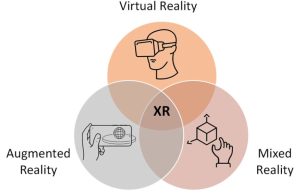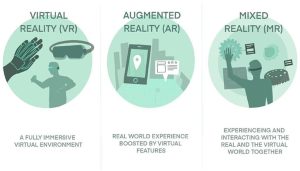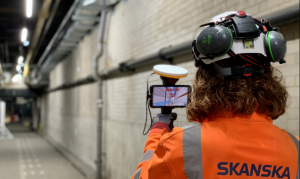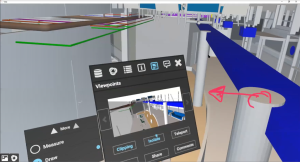12 Mixed Reality and VR Pilot: Transitioning from Pilot to Broader Implementation
Swetha Gopinath
1. INTRODUCTION
Mixed Reality (MR) and Virtual Reality (VR) are transformative technologies that have gained significant traction in the construction industry for their ability to enhance project visualization, collaboration, and efficiency. MR blends real and virtual worlds to produce new environments and visualizations where physical and digital objects coexist and interact in real-time. VR, on the other hand, immerses users in a fully virtual environment, completely detached from the physical world, which is ideal for simulations and training purposes. These technologies enhance visualization, collaboration, and safety in construction projects.
As pioneers in embracing digital innovation, Skanska has recognized the value of MR and VR in enhancing operational efficiency, safety, and stakeholder engagement within construction projects. Through strategic adoption and pilot testing, Skanska has laid the groundwork for broader implementation of these technologies across its organization. This case study delves into Skanska’s transition process, highlighting the challenges encountered, strategic approaches employed, and the resultant benefits, offering insights into how MR and VR technologies are reshaping the construction landscape.

2. RATIONALE FOR STUDYING THE CASE
2.1 Motivation for the problem
The adoption of MR and VR technologies promises numerous benefits, yet the transition from pilot projects to broader implementation often encounters significant challenges related to technology integration, organizational change management, and user engagement. Understanding this process is essential for organizations to effectively harness the potential of MR/VR technologies while navigating integration and scalability complexities.
2.2 Purpose and Focus
The primary purpose of this research is to explore the dynamics of MR/VR technology adoption within organizations, focusing on the challenges, strategies, and best practices associated with transitioning from pilot testing to broader implementation.
This research focuses on understanding the process of scaling MR/VR technologies within organizations post-pilot testing, including integration challenges, adoption barriers, training needs, and strategies for successful implementation and user engagement.
2.3 Unit of Analysis
The unit of analysis for this research is focused on the individual perspective on working within the organization. This encompasses the strategies, challenges, and outcomes associated with individual experiences and viewpoints during the transition process from MR/VR pilot testing to broader implementation within Skanska.
3. LITERATURE REVIEW
The literature on MR and VR in construction highlights their potential to transform project management through enhanced visualization, improved collaboration, and more effective training environments. Studies indicate that these technologies can significantly reduce errors and improve efficiency in construction projects.
3.1 Applications in the Construction Industry
MR and VR in construction are utilized for project visualization, design, training, and safety management. These technologies enable stakeholders to experience and interact with a project virtually before physical construction begins, allowing for early detection of potential issues and facilitating more informed decision-making. Additionally, VR and MR provide advanced training environments, where workers can practice safety protocols and construction procedures in a risk-free setting.
3.2 Skanska’s Use of MR and VR
Skanska’s initial exploration into MR and VR technologies stemmed from a strategic drive to enhance construction processes. Recognizing the competitive edge technology could offer, the company prioritized accuracy, efficiency, and safety. By leveraging VR and MR, Skanska aimed to improve visualization and planning while fostering effective communication among stakeholders. This initial phase served as a crucial foundation for understanding practical applications and gathering data to support broader implementation.
The primary goals of Skanska’s pilot testing phase were multifaceted. The company aimed to evaluate the efficacy of MR and VR in real-world scenarios, identify potential benefits, and gather feedback for further development. Key objectives included enhancing safety training, improving project visualization, and boosting stakeholder engagement. Successful pilot testing would justify investment in these technologies and pave the way for broader adoption across the organization.

3.2.1 Project Visualization and Design
Skanska employs VR for immersive project visualization. For instance, they used Microsoft HoloLens, an MR device, to showcase the interior and exterior of a planned high-rise development in Seattle. This technology allowed potential tenants to explore and experience the space in a highly interactive manner, improving engagement and decision-making. [1]
3.2.2 Training and Safety
Skanska has pioneered VR training solutions to improve safety and efficiency on construction sites. In the UK, they introduced a VR training program that simulates the inspection of temporary works like trenches, formwork, and cofferdams. This program enables supervisors to practice inspection procedures in a virtual environment, significantly enhancing their skills and preparedness without the risks associated with on-site training. [2]
3.3.3 Remote Collaboration
Skanska also utilizes VR and MR to facilitate remote collaboration among project teams. By allowing team members to virtually meet and interact within a 3D model of the project, MR and VR technologies improve communication and collaboration, leading to more cohesive project management and problem-solving. [3] [4]
4. Detailed Description of the Facts Related to the Case
4.1 Overview
The case study delves into Skanska’s strategic integration of Mixed Reality (MR), and Virtual Reality (VR) technologies into their construction projects. Skanska’s initiative reflects a broader industry trend towards digital transformation, where construction companies are increasingly leveraging advanced technologies to optimize project management and enhance stakeholder collaboration. By adopting MR, VR, and AR, Skanska aims to revolutionize traditional construction practices, introducing innovative solutions to improve efficiency, accuracy, and safety throughout the project lifecycle.

4.2 Initial Drivers
The decision to embrace MR and VR technologies stemmed from Skanska’s recognition of the evolving complexities within the construction industry. Traditional planning and communication tools were deemed inadequate in addressing the multifaceted challenges faced by modern construction projects. Skanska identified a pressing need for innovative solutions capable of streamlining project management processes, enhancing collaboration among stakeholders, and mitigating risks associated with errors and delays. Embracing MR and VR represented a strategic response to these challenges, driven by the company’s commitment to maintaining a competitive edge in the industry.
4.3 Vision and Goals
Skanska’s vision for implementing MR and VR technologies centered on transforming the construction process into a more streamlined, efficient, and transparent endeavor. The company aimed to empower project teams with real-time access to detailed 3D models, facilitating better decision-making and reducing the likelihood of costly rework. By enhancing on-site planning, understanding work in progress, and fostering stakeholder engagement through immersive visualization, Skanska sought to redefine the standards of excellence in construction project management. The overarching goal was to leverage MR and VR technologies to optimize project outcomes, enhance client satisfaction, and drive sustainable growth.
Transitioning from pilot testing to broader implementation of MR/VR technologies involves navigating several interconnected factors. Technology integration, organizational change management, user engagement and training, scalability and infrastructure, pilot implementation, and integration challenges are all critical considerations during this phase. Strategic approaches, such as phased rollout strategies, comprehensive training programs, strategic partnerships, and establishing feedback loops, are essential for overcoming challenges and ensuring successful adoption.
4.4 Challenges in Transitioning to Broader Implementation
Scalability Issues: Scaling MR and VR technologies from pilot projects to broader applications presented significant scalability challenges for Skanska. Ensuring uniform adoption across various construction sites required robust infrastructure, consistent training, and adaptable software solutions. Addressing scalability issues was crucial to facilitating a seamless and effective transition, avoiding disruptions and optimizing resource allocation.
Cost Considerations: The substantial initial investment in VR and MR technology necessitated a thorough cost-benefit analysis to justify expenses. Additionally, ongoing maintenance and updates demanded careful financial planning to ensure the long-term sustainability of these technologies in construction operations. Addressing cost considerations was essential to optimize the return on investment for MR and VR implementations, aligning expenditures with strategic objectives and project outcomes.
User Adoption and Training: Ensuring user adoption and proficiency with new technologies demanded comprehensive training programs and continuous support to facilitate the transition. Employees needed to acquire the necessary skills and knowledge to leverage MR and VR effectively in their respective roles. Overcoming resistance to change and fostering a culture of innovation were critical for successful user adoption, driving organizational readiness and engagement.
Additionally, addressing concerns related to motion sickness was paramount during the training phase. Given the immersive nature of VR experiences, some individuals may experience discomfort or motion sickness, particularly during extended use. Therefore, training programs included guidance on managing and mitigating motion sickness symptoms, such as taking regular breaks, adjusting display settings, and gradually acclimating to VR environments. By proactively addressing this issue, Skanska ensured that employees could engage with MR and VR technologies comfortably and effectively, enhancing overall user adoption and satisfaction.

4.5 Strategic Approaches to Overcome Challenges
Phased Rollout Strategy: Skanska implemented a phased rollout strategy, gradually introducing MR and VR technologies across different projects and departments. This approach prioritized areas with the most significant potential benefits, facilitating smoother adoption and risk management. By incrementally scaling up implementations, Skanska minimized disruptions and optimized the learning curve for users, ensuring the successful integration of MR and VR into construction operations.
Comprehensive Training Programs: Tailored training programs were developed to ensure successful adoption. These programs included hands-on workshops, online resources, and continuous support, empowering employees to utilize MR and VR effectively. By investing in training initiatives, Skanska aimed to maximize the potential of MR and VR applications across its construction projects, fostering competence and confidence among users and driving continuous improvement.
Strategic Partnerships: Collaborations with technology partners played a crucial role in overcoming challenges. These partnerships facilitated the creation of customized solutions tailored to Skanska’s specific needs. By leveraging the expertise and resources of technology partners, Skanska enhanced its capabilities and accelerated the adoption of MR and VR in construction operations, fostering innovation and driving competitive advantage.
Establishing Feedback Loops: Continuous improvement was achieved by establishing feedback loops where users provided input on their experiences. This feedback was instrumental in refining technology and applications, ensuring ongoing effectiveness. By soliciting feedback and iterating on implementations, Skanska demonstrated a commitment to driving innovation and delivering value to its stakeholders, fostering a culture of continuous learning and improvement.
5. Data Analysis
5.1 Data Collection
Data for this study was collected through an interview with Graham Condit, Director, Emerging Tech – West Region at Skanska. The interview focused on the motivations, challenges, and successes associated with the adoption of MR and VR technologies.
The data collected includes detailed accounts of how MR and VR technologies were used in Skanska’s pilot projects. This involves insights into the technologies employed, the processes followed, and the outcomes achieved.
5.2 Case Study Approach
This qualitative case study employed an interview to gather in-depth insights from Skanska personnel. The case study approach allowed for a comprehensive understanding of how MR and VR technologies were piloted and integrated into various projects on an organizational scale from the individual’s perspective.
Discovery Phase
During the discovery phase, Skanska embarked on an extensive exploration and evaluation of Mixed Reality (MR), Virtual Reality (VR), and Augmented Reality (AR) technologies to identify their potential applications and benefits in enhancing project management and stakeholder engagement. This phase involved:
- Technological Exploration: Skanska conducted comprehensive research and testing on various MR, VR, and AR technologies available in the market. This exploration included the assessment of hardware devices, software platforms, and development tools to determine their suitability for construction projects. Skanska engaged with technology vendors, attended industry conferences, and participated in workshops to gain insights into the latest advancements and emerging trends in MR/VR technology.
- Pilot Testing: As part of the discovery phase, Skanska initiated pilot projects to evaluate the feasibility and effectiveness of MR and VR tools in real-world construction scenarios. These pilot projects were carefully designed to represent typical construction challenges and workflows, allowing Skanska to assess the practical applications of MR/VR technologies. Skanska collaborated with project teams, subcontractors, and clients to gather feedback and identify areas for improvement during the pilot testing phase.
- AI and Data Utilization: Skanska leveraged Artificial Intelligence (AI) technologies to analyze vast amounts of data related to construction projects, market trends, and industry benchmarks. AI-driven analytics provided valuable insights into project performance, resource utilization, and risk assessment. By harnessing the power of AI, Skanska gained a deeper understanding of project dynamics and identified opportunities for optimization and innovation. Data-driven decision-making became a cornerstone of Skanska’s approach to integrating MR/VR technologies into construction operations.
Dissemination Phase
Following the discovery phase, Skanska focused on disseminating knowledge and insights gained from pilot projects across the organization and with external stakeholders. This phase aimed to ensure that the benefits of MR and VR technologies were fully realized and integrated into daily operations. Key aspects of the dissemination phase included:
- Internal Collaboration: Skanska established collaborative platforms and communication channels to facilitate internal knowledge sharing and collaboration. Teams across different departments and geographical locations were encouraged to share information, best practices, and lessons learned from pilot projects. Skanska organized internal workshops, webinars, and training sessions to educate employees about MR/VR technologies and their potential applications in construction projects.
- Stakeholder Engagement: Skanska utilized MR and VR technologies to engage with external stakeholders, including clients, investors, regulatory agencies, and the public. Immersive visualizations and interactive experiences were created to showcase project designs, construction progress, and safety protocols. Stakeholders were invited to virtual site tours, design reviews, and safety training sessions conducted using MR/VR platforms. These initiatives fostered greater transparency, collaboration, and trust among stakeholders, leading to improved project outcomes and stakeholder satisfaction.
- Knowledge Sharing: Skanska implemented knowledge sharing initiatives to disseminate best practices and lessons learned from pilot projects. Case studies, white papers, and project reports were published to document the experiences and insights gained from integrating MR/VR technologies into construction operations. Skanska actively participated in industry forums, conferences, and seminars to share its expertise and contribute to the collective knowledge base of the construction industry. By promoting knowledge sharing and collaboration, Skanska demonstrated its commitment to driving innovation and advancing the adoption of MR/VR technologies in construction.
6. Discussion of Patterns and Theories
6.1 Patterns Identified
Enhanced Visualization: The use of MR and VR technologies has profoundly impacted the ability of construction teams to visualize complex projects. Traditional 2D plans can be limiting and often lead to misunderstandings or misinterpretations of the design. MR and VR technologies provide a 3D perspective that is far more intuitive and informative, allowing stakeholders to walk through a virtual representation of the project. This enhanced visualization capability helps in identifying potential issues early, improving accuracy in planning and execution. It also allows clients to better understand the project scope and design, leading to more informed decision-making and increased satisfaction.
For example, using MR, project managers can overlay virtual models onto physical construction sites to assess progress and ensure accuracy. This capability significantly reduces the likelihood of errors and rework, as discrepancies between the plan and actual construction can be identified and addressed promptly. The interactive nature of VR also allows for immersive experiences where users can explore the construction site virtually, gaining insights that are not possible with traditional methods. These technologies have proven to be instrumental in reducing design conflicts and improving the overall quality of construction projects.

Improved Collaboration: MR and VR technologies facilitate improved collaboration among construction teams, both internally and with external stakeholders. Real-time interactive models allow team members to collaborate more effectively by visualizing and interacting with the project in a shared virtual environment. This capability enhances communication, as team members can easily convey ideas and changes, reducing misunderstandings and ensuring that everyone is on the same page.
For instance, Skanska has used these technologies to conduct virtual meetings where team members from different locations can interact within a 3D model of the project. This approach has led to more cohesive project management and efficient problem-solving, as issues can be discussed and resolved collaboratively in real-time. The ability to visualize the project collectively helps in aligning project goals and activities, leading to a more streamlined and efficient construction process.
Cost and Time Efficiency: One of the significant advantages of MR and VR technologies in construction is their potential to save costs and improve time efficiency. Virtual mockups and simulations allow teams to detect issues early in the construction process, which helps avoid costly rework and delays. By identifying potential problems before they occur, these technologies ensure that projects are completed on time and within budget.
For example, Skanska’s use of VR for safety training and site inspections has led to significant improvements in operational efficiency. By simulating various scenarios and procedures, workers can be better prepared for real-world challenges, reducing the risk of accidents and improving overall site safety. These training programs have been shown to enhance skill levels and preparedness without the risks associated with on-site training, leading to cost savings and more efficient project execution.
6.2 Theories and Models
Technology Adoption Life Cycle: The Technology Adoption Life Cycle model is a crucial framework for understanding the adoption process of new technologies within organizations. This model outlines the stages that organizations typically go through when adopting new technologies, starting with pilot testing and progressing toward broader implementation. The stages include Innovators, Early Adopters, Early Majority, Late Majority, and Laggards.
In the context of Skanska, the pilot testing phase involved exploring the feasibility and benefits of MR/VR technologies in specific projects. This phase allowed Skanska to gather valuable insights and make necessary adjustments before moving to broader implementation. By understanding this cycle, organizations can anticipate challenges at each stage and develop strategies to address them. For example, during the Early Adopters phase, organizations may need to focus on building a strong business case and securing leadership support to drive adoption.
Change Management Theories: Change management theories emphasize the importance of effective communication, leadership support, and employee engagement in successfully implementing new technologies. One widely used model is the ADKAR model, which stands for Awareness, Desire, Knowledge, Ability, and Reinforcement. This model provides a structured approach to managing change and ensuring successful implementation.
In Skanska’s case, creating awareness about the benefits of MR/VR technologies was the first step in the change management process. This involved communicating the value proposition and potential impact on project outcomes to all stakeholders. Building a desire among employees to adopt these technologies required addressing any concerns or resistance to change. Providing the necessary knowledge and training ensured that employees had the skills and confidence to use the technologies effectively. Finally, reinforcing the change through continuous support and feedback helped to sustain the adoption and integration of MR/VR technologies within the organization.
User-Centered Design: User-centered design is an approach that focuses on developing technologies that meet user needs and preferences, thereby enhancing user engagement and adoption. This approach involves understanding the practical needs of the workforce and designing MR/VR solutions that are intuitive and easy to use.“
For Skanska, adopting a user-centered design approach meant involving end-users in the development and testing of MR/VR applications. This involvement ensured that the technologies were aligned with the practical needs of the construction teams and were user-friendly. For instance, by incorporating feedback from users during the pilot testing phase, Skanska was able to refine the applications to better suit the requirements of their projects. This approach not only improved user satisfaction but also increased the likelihood of successful adoption and integration of the technologies.
7. Connection to the Larger Scheme of Things
Emerging MR and VR Technologies: As technology continues to advance, Skanska remains dedicated to staying at the forefront of innovation. Emerging technologies such as augmented reality (AR) and mixed reality (MR) present exciting opportunities to revolutionize project planning, visualization, and safety within the construction sector. By leveraging these advancements, Skanska aims to further enhance its construction processes and outcomes. For example, MR can enable project managers to overlay virtual models onto physical construction sites, providing real-time insights and facilitating more informed decision-making.
Potential Areas for Expansion: Skanska recognizes the potential for expanding the use of MR and VR technologies into new areas of its operations. This expansion could include the development of more advanced training programs, the implementation of enhanced project management tools, and the integration of real-time collaboration platforms. By continually innovating and exploring new applications, Skanska seeks to maintain its competitive edge and drive operational efficiency across all projects. For instance, Unity, a leading platform for creating and operating real-time 3D content, offers tools and solutions that can support Skanska’s expansion into these areas.
Looking ahead, Skanska aims to fully integrate MR and VR technologies into its standard practices. This integration involves not only leveraging these technologies within its own projects but also advocating for industry-wide standards and promoting their benefits to clients and partners. By embracing MR and VR as core components of its operations, Skanska aims to achieve safer, more efficient, and higher-quality construction projects. This aligns with the company’s commitment to continuous improvement and innovation.
8. Conclusion
In conclusion, Skanska’s meticulous journey from initial pilot testing to widespread implementation of Mixed Reality (MR) and Virtual Reality (VR) technologies marks a pivotal moment in the construction industry’s embrace of digital innovation. Through strategic planning, collaborative partnerships, and an unwavering commitment to addressing challenges, Skanska has seamlessly integrated MR and VR into its workflows, reaping significant rewards in terms of enhanced efficiency, elevated safety standards, and enriched stakeholder engagement. By leading the charge in digital transformation, Skanska not only sets a high standard for the industry but also demonstrates the profound potential of technology to revolutionize traditional construction practices. This transition underscores Skanska’s forward-thinking approach and serves as a beacon for the construction sector, inspiring others to embrace innovation and embrace the transformative power of MR and VR technologies for a brighter, more efficient future in construction.
9. REFERENCE
[1] BD+C Network. “Skanska to Use Microsoft HoloLens.” Retrieved from BD+C Network, Skanska will use Microsoft HoloLens to lease planned Seattle high rise (bdcnetwork.com)
[2] Skanska Global. “Virtual Training, Real Benefits.” Retrieved from Skanska Global, Virtual training, real benefits | Skanska – Global corporate website
[3] Skanska USA. “Immersive Experiences.” Retrieved from Skanska USA, Immersive Experiences | www.usa.skanska.com
[4] Skanska UK. “Smart Wearables and Digital Engineering.” Retrieved from Skanska UK, Smart wearables | www.skanska.co.uk
Media Attributions
- Figure 1: Immersive technologies- Virtual Reality and Mixed Reality.
- Figure 2: Differentiation of immersive experience simulation tools.
- Figure 3: Skanska’s Alison with Trimble Site Vision.
- Figure 4: Frequency of Experiencing Motion Sickness in VR
- Figure 5: View, markup and create new issues in VR

